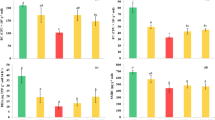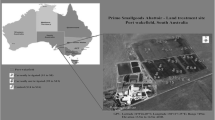Abstract
Water reuse is a proposed strategy for utilizing or disposing of poor quality drainage water produced in the westside of central California. This 2-year field study evaluated the ability of two potential forage species to tolerate irrigation with water high in salinity, boron (B), and selenium (Se). The species used were: Sporobulus airoides var. salado (alkali sacaton) and Medicago sativa var. salado (alfalfa). After first year establishment with good quality water (<1 dS m−1), the two species were furrow-irrigated with drainage effluent that had an average composition of sulfate-dominated salinity ((electrical conductivity (EC) of 6.2 dS m−1)) B (5 mg l−1), and Se (0.245 mg l−1). Both crops were clipped monthly from June to October of each year. Total dry matter yields averaged between 11 and 12 mg ha−1 for both crops irrigated with effluent for two growing seasons. Plant concentrations of Se ranged from a low of 1.3 mg kg−1 in alkali sacaton to a high of 2.5 mg kg−1 in alfalfa, while B concentrations ranged from a low of 60 mg kg−1 in alkali sacaton to a high of 170 mg kg−1 in alfalfa. Chemical composition of the soil changed as follows from preplant to post-irrigation after two seasons with drainage effluent: EC from 2.78 to 6.5 dS m−1, extractable B from 1.9 to 5.6 mg l−1, and no change in extractable Se at 0.012 mg l−1 between 0 and 45 cm. Between 45 and 90 cm, EC values increased from 4.95 to 6.79 dS m−1, extractable B from 2.5 to 4.8 mg l−1, and no change in extractable Se at 0.016 mg l−1. Increased salinity and extractable B levels in the soil indicate that management of soil salinity and B will be necessary over time to sustain long term reuse with poor quality water.
Similar content being viewed by others
References
Apaslan M and Gunes A 2001 Interactive effects of boron and salinity stress on the growth, membrane permeability and mineral composition of tomato and cucumber plants. Plant Soil 236, 123–128.
Bañuelos G S and Meek D W 1990 Accumulation of selenium in plants grown on selenium treated soil. J. Environ. Qual. 19, 772–777.
Bañuelos G S and Mayland H F 2000 Absorption and distribution of selenium in animals consuming canola grown for selenium phytoremediation. Ecotoxicol. Environ. Safety 46, 322–328.
Bañuelos G S and Akohoue S 1994 Comparison of wet digestion and microwave digestion on selenium and boron analysis in plant samples. Commun. Soil Sci. Plant Anal. 25, 1655–1670.
Bell P F, Parker D R and Page A L 1992 Contrasting selenate-sulfate interaction in selenium-accumulating and nonaccumulating plant species. Soil Sci. Soc. Am. J. 56, 1818–1824.
Bingham F T, Strong J E, Rhoades J D and Keren R 1985 An application of the Mass-Hoffman salinity response model for boron toxicity. Soil Sci. Soc. Am. J. 49, 672–674.
California Department of Water Resources 2001 Findings and recommendations to develop the six-year activity plan for the department's drainage reduction and reuse program. Investigators: Letey J, Gratton S, Oster J D, Birkle D E. p. 153. Task Order no. 5. Contract No. 98–7200-B80933. Sacramento, CA.
Cervinka V 1994 Agroforestry farming system for the management of selenium and salt on irrigated farmland. In Selenium in the Environment. Eds.WT Frankenberger Jr and S Benson. pp. 237–250. Marcel Dekker Inc., New York.
Frankenberger W T Jr and Karlson U 1994 Microbial volatilization of Se from soils and sediments. In Selenium in the Environment. Eds. W T Frankenberger Jr and S Benson. pp. 369–389. Marcel Dekker Inc., New York.
Fresno Department of Agriculture 2001 Agricultural crop and livestock report. Fresno County, Fresno, CA.
Howell T A, Meek D W, Phene C J, Davis K R and McCormick R L 1984 Automated weather data collection for research on irrigation scheduling. Trans. ASAE 27, 386–391.
Maas E V 1986 Salt tolerance of plants. Appl. Agric. Res. 1, 12–26.
Maas E V and Hoffman G J 1977 Crop salt tolerance — current assessment. J. Irrig. Drain. 103, 115–134.
Mayland H F, James L J, Panter K E and Sonderregger 1989 Selenium in seleniferous environments. In Selenium in Agriculture and the Environment. Ed. LWG Jacobs. pp. 15–50. SSSA Spec. Publi. 23. ASA, CSSA, and SSA, Madison, WI.
NCSS 2000 Statistical system for windows. Kaysville, UT. 91 pp.
Ohlendorf H M and Hothem R L 1995 Agricultural drainwater effects on wildlife in central California. In Handbook of Ecotoxicology. Eds. D G Hoffman, B A Rattner, G A Burton Jr and J Cairns. pp. 577–595. Lewis Publishers, Boca Raton, FL.
Ohlendorf H M, and Santos G M 1994 Kesterson Reservoir-past, present, and future: an ecological risk assessment. In Selenium in the Environment. Eds. W T Frankenberger Jr and S Benson. pp. 69–117. Marcel Dekker Inc., New York.
Ohlendorf H M, Hoffman D J, Saike M K and Aldrich T W 1986 Embryonic mortality and abnormalities of aquatic birds: apparent impacts of selenium from irrigation drain water. Sci. Total Environ. 52, 49–63.
Oster J D, Shainberg J and Abrol J P 1999 Reclamation of saltaffected soils. In Agricultural Drainage. Eds. R W Skaggs and J Van Schilfgaarde. pp. 659–694. AgronomyMonograph 38. ASA, CSSA, SSSA, Madison, WI.
Presser T S 1994 Geological origin and pathways of selenium from the California Coast Ranges to the West-Central San Joaquin Valley. In Selenium in the Environment. Eds.WT Frankenberger Jr and S Benson. pp. 139–156. Marcel Dekker Inc., New York.
Parker D R, Page A L, and Thomason D N 1991 Salinity and boron tolerances of candidate plants for the removal of selenium from soils.J. Environ. Qual. 20, 157–164.
San Joaquin Valley Drainage Program 1990 The Problem. In A Management Plan for Agricultural Subsurface Drainage and Related Problems on the Westside San Joaquin Valley. Eds. US Department of Interior and California Department of Water Resources, Sacramento, CA. 183 pp.
Shannon M C, Suhayda C G, Grieve C M, Grattan S R, Francois L E, Poss J A, Donovan T J, Draper J H and Oster J D 1997 Water use of Eucalyptus camoldulensis clone 4544 in saline drainage reuse systems. Report No. 2 California Department of Water Resources, Sacramento, CA.
Sharmasarkar S 1996 Soil selenium geochemistry in range and coal mine environments of Wyoming. Dissertation, University of Wyoming, Laramie, WY. 93 pp.
Shennan C, Grattan S R, May D M, Hillhouse C G, Schechtman D P, Wander M, Roberts B, Tafoya S, Burau R G, McNeish C and Zelinski L 1995 Feasibility of cyclic reuse of saline drainage in a tomato-cotton rotation. J. Environ. Qual. 24, 176–178.
UC Salinity/Drainage Program 1998 Annual Report. WRC Prosser. Trust, Centers for Water and Wildland Resources. Division of Agriculture and Natural Resources, University of California.
Zayed A, Pilon-Smits E, de Souza M, Lin Z Q and Terry N 2000 Remediation of selenium-polluted soils and waters by phytovolatilization. In Phytoremediation of Contaminated Soil and Water. Eds. N Terry and G S Banuelos. pp. 61–84. CRC Press, Inc., Boca Raton, FL.
Author information
Authors and Affiliations
Rights and permissions
About this article
Cite this article
Bañuelos, G.S., Sharmarsakar, S., Cone, D. et al. Vegetative approach for improving the quality of water produced from soils in the westside of central California. Plant and Soil 249, 229–236 (2003). https://doi.org/10.1023/A:1022563509055
Issue Date:
DOI: https://doi.org/10.1023/A:1022563509055




